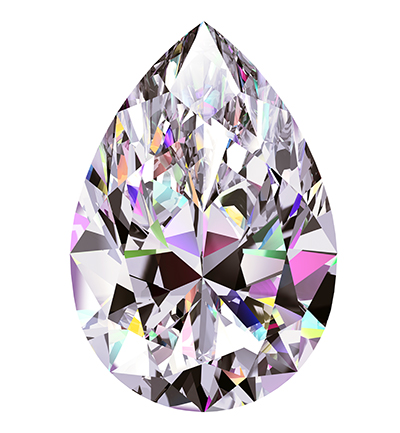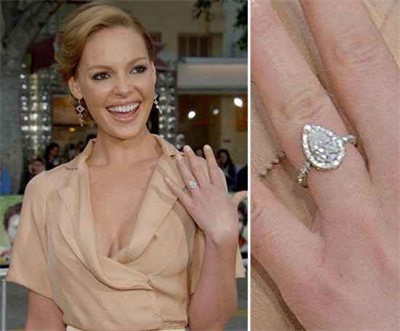Pear Diamonds- Where Breathtakingly Fancy Meets Price Practicality

Pear Diamond Illustration
You may have seen a pear diamond on a jewel before and wondered what kind of a cut it is. Pear-cut diamonds, also famously called the tear-drop diamond is one of the two asymmetrical cuts that are used in haute jewelries for their rare and fancy looks. Pear is arguably one of the finest shapes in gems that are sold worldwide.
Only 4% of the pear diamonds are certified by GIA which makes it an exceedingly rare cut. Notwithstanding its scanty production, pear diamonds are quite skimpily priced, a privilege that jewelers extract by the advantage of the shape.
A pear has a 44% yield from a rough diamond which is far greater than round-cuts. That makes round cuts so extraordinarily pricey and pear cuts surprisingly inexpensive.
The Numbers That Make a Pear Cut Ideal
The pear is graded into four categories, namely, Ideal, Very Good, Good and fair. The Ideal pear has the maximum sparkle. So, coming to the dimensions and measurements, a pear cut is certified ideal when it has a 56 to 62% table, depth between 59 and 65%, a thin to marginally thick girdle, no culet and 1.45:1.60 length to width ratio. So, if you can grab a pear shaped diamond that has numbers within the aforementioned range, then congrats, you have got yourself an ideal cut diamond. Cuts do not get better than Ideal, which is why they are priced maximally. However, Very Good cut is not so bad either. In fact, if you look at the numbers, they are not far removed from the Ideal grade. The differences between an Ideal pear cut and the subsequent grades besides the % numbers is the presence of a culet, thickness of the girdle and some minor differences in measurements in other areas.

The elegance of pear-shaped diamonds is diminished by
the presence of a bow-tie effect.
A Note for the Buyers
So, as a buyer, what should you know about a pear diamond. Like all other cuts and kinds, pear diamonds too have a set table of values that make them qualitatively superior than others. So, for a decently priced, reasonable quality pear shaped diamond, aim for one that has clarity between SI2 and 1, color H and cut excellent. With pear diamonds, there is no stress on higher carat weight. The pear is a unique shape that gives the diamonds the advantage of size. Being slightly elongated, the cut can make a small stone look nearly twice its mass. That, coupled with the reasonable pricing of pear diamonds makes it easy for common buyers to easily afford a surprisingly large pear rock.
. Buy only white Pear diamond, the color concentrates at the point of the Pear and you will end up with a diamond of two color shades.
Do not but flat Pears, they will have “dead” area in the center.
Famous Pear-Cut Engagement Rings
Pear diamonds have been wildly endorsed by celebrities around the world. Remember Angelina Jolie’s statement-making emerald drop earrings from the 2009 Oscars. The emergence of pear cut dates back to the beginning of this millennium. However, more recently, a lot of Hollywood celebs have been spotted brandishing this cut in their accessories. The following are the most popular pear diamond engagement rings seen in the recent past.
Katherine Heigel’s Halo Pear-Cut Sparkler:

Katherine Heigel’s Halo Pear diamond ring
It’s a 3 carat pear-cut diamond surrounded by a thin halo with micro paved diamond scraps. The ring has a distinct Art Deco influence and the French-set band only amplifies the perfection of the design.
Victoria Beckham’s Jaw-Dropping Pear Rock:

One of the many high-brow baubles she has acquired over the years of her marriage with football stud David Beckham, this one is somewhere between 15 and 17 carats, tastefully mounted on a micro-pave platinum band.
Jessica Simpson’s Accented Pear shaped diamond engagement Ring:

Jessica Simpson’s 4 carat pear diamond engagement ring is dazzling, if anything. Set on a diamond inlaid band, this one is a simple yet striking feature.
Why Buy a Pear Diamond?
Why buy a pear shaped diamonds? you might ask. There is more than one good reason to choose this fascinating cut. The pear is one of the very few fancies that has close resemblance with brilliant cuts, and this one has faceting similarities with the round brilliant cut, which you’d surely know has the most intense sparkle. Owing to that, pear shaped diamonds demonstrates a superior fire and brilliance than other fancy cut diamonds.
Another reason to buy a pear diamond among other shapes is its dynamism. A round or a square diamond can be worn only one way. In fact, no cut other than the pear and trillion can be worn in two different ways. The pear can be worn both pointy sides up or down. The shape has such a versatility to it that gives it a classic feeling, yet a distinctly modern look.
Pear shaped diamond rings are one of the most coveted jewelry of this decade. Jewelry bedecked with delicate and shapely pear cut gems make for statement pieces. Pear stones, especially in diamond rings make a design both feminine and elegant, two qualities that are the most coveted in jewelry.
A pear-shaped diamond ring embodies the sharpness of silhouette of a Marquise cut and the blinding brilliance of a round cut. Brought together, these styles give birth to the pear shape whose style and grace are to this day unmatched. Pear diamonds work their magic on a solitaire setting but even in a cluster gem setting, there is no eclipsing their radiance and beauty. The stone sparkles mightily alone and harmoniously in company.
The Geometry of Pear Shaped Diamonds
The pear is a fancy cut, which essentially makes it a shape diverse from the classic round or square. The pear shape, also named after the fruit is more reminiscent of a drop of tear than a pear. It has the distinctiveness of shape like a droplet and the brilliance of the same on a lily pad. The pear cut famously brings together best of both the round and Marquise cuts. In this regard, the anatomy of a pear-cut diamond deserves to be analyzed. Getting to know the geometry of a cut gives one the discerning eye they need to make sound judgement calls in choosing a particular stone.
The geometry of a pear-shaped diamond can be broken down into five parts, namely, head, shoulder, belly, wing and point. It is the outline of the stone that gives the pear cut its signature shape. While some pear-shaped diamonds are more rounded and plumper, others are skinny and slender. Whatever the silhouette is, the rounded shoulders and wings are its hallmarks. When picking a stone for a pear-shaped diamond ring, go for the one that has well rounded shoulders and attractively arched wings. However, if you are in search of a narrow silhouette go for the flat wings because that’s what achieves the elongated and slender look as opposed to fuller silhouettes that create the short and stubby look.
Similar to their round cut brilliant counterparts, pears are faceted to deliver the maximum brilliance and scintillation.
Symmetry Is a Must for a Pear-Shaped Diamond Ring
Whether you are planning to build a pear-shaped diamond ring or putting it a pendant, symmetry should be a constant for a pear cut diamond. It plays a big role in the overall looks of the stone. Especially for fancy shaped diamonds like the pear, Marquise, oval and heart, symmetry is key to the beauty. But how do you measure the symmetry of a stone? In your mind, draw a straight vertical line through the center of the stone. Do the two halves look mirror images of one another or are there any subtle differences that meet the eye. The two halves should look one and the same for that alone guarantees a flawless symmetry.
A Setting that Enhances and Guards
For diamonds of any shape, you want a setting that enhances its beauty but also protects it from accidental knocks and bumps. Especially for a delicate cut like pear, you want a pear-shaped diamond ring setting that does both. You have two options that come on top, a bezel and a V-prong.
The Ideal Numbers
The ideal length to breadth ratio for a pear-shaped diamond ring lies between 1.50 and 1.75. Anywhere in this range you can find the proportionate stone.
Pointy Side Up or Down?
The traditional way is to wear the pointy end down, but you are at liberty to choose your style. On a finger, the upward pointed pear diamond ring achieves a slender look. Alternately, you can also put it on a horizontal setting for a striking look.